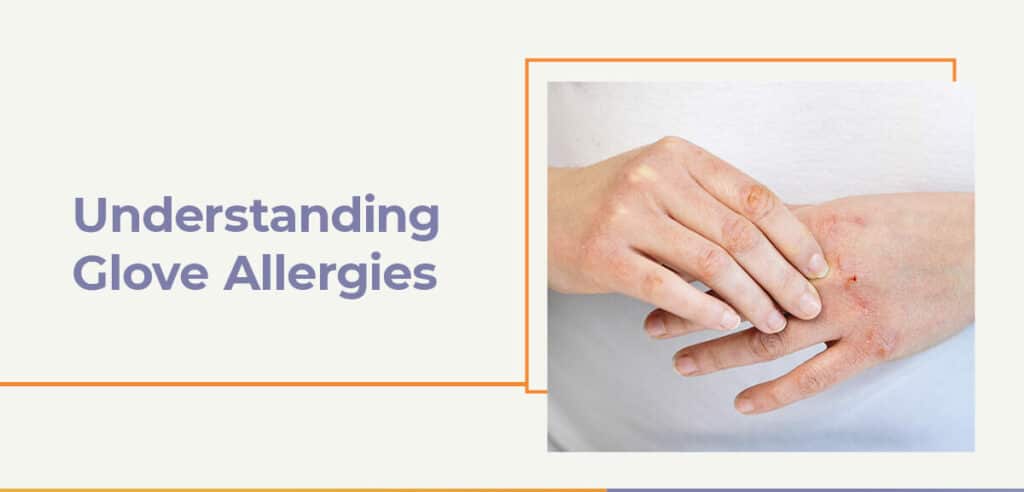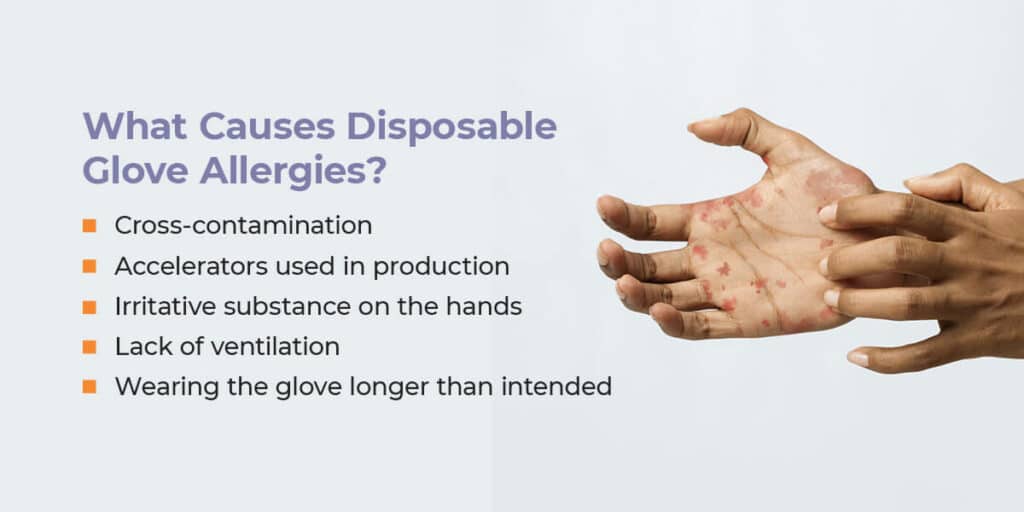
Understanding Glove Allergies
Latex allergies are caused by the latex proteins in natural rubber products like disposable gloves. A glove allergy can occur through direct contact or by inhaling latex particles, so it’s crucial that employers use hypoallergenic options to protect those with sensitive skin.
Learn more about the common types of glove materials, how to prevent allergic reactions from gloves and the hypoallergenic options out there.
Types of Disposable Glove Materials
There are multiple materials that go into making gloves, and the types of disposable gloves include:
- Polyethylene: Polyethylene gloves are a thin material made for light-duty tasks. Food workers often see them as the economical choice when they need to change gloves frequently between prep tasks.
Latex: When you need a versatile type of glove, latex gloves are an excellent choice. While it does contain a protein that can cause allergies in some people, the material is flexible and practical for nearly any application other than high-risk uses. - Neoprene: The flexible, heat-resistant material neoprene makes a thick and reusable glove. These gloves are perfect for high-risk applications like dishwashing and wet handling.
- Vinyl: Made for food service, vinyl gloves are safe, comfortable and latex-free. They can be used for food prep, cooking or even low-risk janitorial work.
- Nitrile: Perhaps the most versatile type of glove material, nitrile gloves come in various thicknesses and styles. They can be used for most tasks and are resistant to many chemicals and other hazardous substances. They also make excellent gloves for allergic hands, as reactions to the material are extremely rare.

What Causes Disposable Glove Allergies?
There are several reasons disposable gloves might cause an allergic reaction, including:
- Cross-contamination: While there are non-latex options that can keep your skin safe, sometimes these gloves are made in the same factories as latex gloves, which means there’s a possibility of cross-contamination of latex proteins. SUNLINE Supply is an company that carries only the highest-rated personal protective equipment (PPE), so you can rest assured you receive high-quality protective gear for your company.
- Accelerators used in production: The accelerators like carbonates and thiurams used in the production of disposable gloves could also cause an allergic reaction. For instance, while rare, the petroleum used in vinyl gloves has caused a vinyl allergy in some users. At the same time, many chemicals used in nitrile can cause nitrile glove allergy symptoms like a red, itchy rash.
- Irritative substance on the hands: Another common cause of allergic reactions is certain substances on the hand. While soaps and scented lotions aren’t typically irritating on an exposed hand, gloves might exacerbate the response in some users by pressing the substances against the hand.
- Lac of ventilation: A lack of proper glove ventilation can be another cause of an allergic reaction. Different gloves have varying degrees of breathability, and for those without adequate ventilation, the glove can sweat and cause the material to permeate chemicals onto the hand.
- Wearing the glove longer than intended: Most disposable gloves have an intended wearing time and a chemical resistance level. Should the glove be worn longer than intended, chemicals might leak through and cause a glove rash on the hands.
How Common Are Disposable Glove Allergies?
Latex allergy is rare — affecting approximately 1% of the population. Allergic contact dermatitis is a common type of reaction in these cases.
Certain groups tend to have a greater risk of developing a latex allergy. These groups include:
- People who have multiple surgeries or medical procedures, such as those who frequently use latex catheters.
- Healthcare workers and other people who often wear latex gloves, such as food handlers, hairdressers, security personnel, painters and first responders.
- People with a personal or family history of allergies, such as hay fever or food allergies.
New cases of latex allergies are likely less common because healthcare workers use fewer latex products today. Now many healthcare centers use non-latex gloves and other protective equipment.
Disposable Glove Allergy Symptoms
Disposable glove allergy symptoms can range from mild to severe. The allergic reaction depends on your level of sensitivity to the material and the amount you touch or inhale. The reaction can worsen with each exposure. An allergic reaction can also occur by breathing in latex particles released into the air when someone removes their latex gloves.
Some workers who experience a latex glove allergic reaction might have a Type I latex allergy, which is a hypersensitivity to the latex protein. This type of reaction typically occurs within minutes of exposure, causing symptoms like:
- Sneezing
- Skin redness
- Hives or rash
- Scratchy throat
- Itchy, watery eyes
- Runny nose
- Swelling and itching of the skin, particularly on the hands
In some cases, a latex glove allergy can involve more severe reactions, including:
- Nausea
- Cough
- Abdominal cramps
- Dizziness
- Low blood pressure
- Difficulty breathing
- Wheezing
- In rare cases, anaphylaxis shock and death
Another glove-related allergic reaction is Type IV response, or allergic contact dermatitis. In chronic cases, this reaction manifests in itchy, red blisters or dry skin and scabbing sores.
Some people show symptoms of both Type I and Type IV reactions, so it’s essential to receive a diagnosis from a medical professional to determine the root of the allergic reaction.
Disposable Glove Allergy Relief and Prevention
While glove allergic reaction can be highly uncomfortable, there are ways to prevent a reaction:
- Wash your hands with mild soap and dry thoroughly after removing your gloves.
- Do not use oil-based hand creams while using latex gloves.
- Do not use wet gloves or wear them with wet hands.
- Use a cotton liner on the inside of the gloves in case of prolonged exposure.
- Treat underlying hand eczema.
- Use powder-free gloves.
People who develop an allergic reaction to latex should avoid using the material. They should stick to non-latex or hypoallergenic gloves to protect themselves and prevent a glove rash on the hands. Anyone around the allergic person should also wear latex-free gloves or powder-free latex options. The same goes for employees with a vinyl allergy.
Employers can help prepare for glove allergies by educating staff about possible signs and symptoms. Using alternative products is a simple solution to an otherwise troublesome situation.

Find Hypoallergenic Disposable Gloves at SUNLINE Supply
Whether in the food or healthcare industry, it’s essential to look for high-quality PPE that’s safe for your employees. At SUNLINE Supply, we offer only latex-free, allergy-safe disposable gloves to provide safe and effective PPE for employees. Choose from alternatives ideal for sensitive skin, such as nitrile and vinyl gloves.
Our high-quality products come in bulk and are available at the best prices. Place your order online or contact our team for more information on available products.


Thanks for the insight